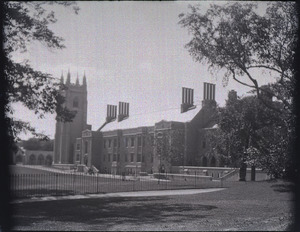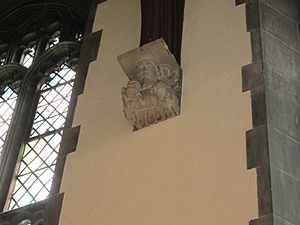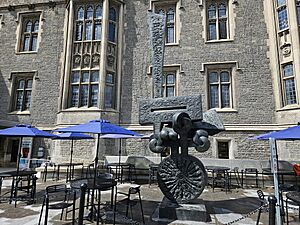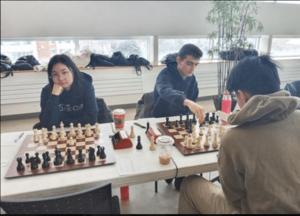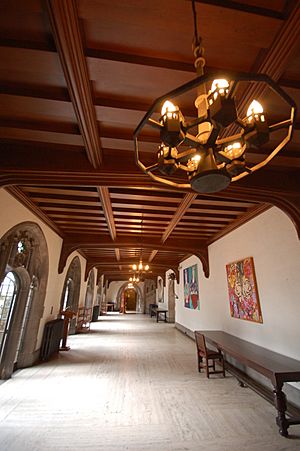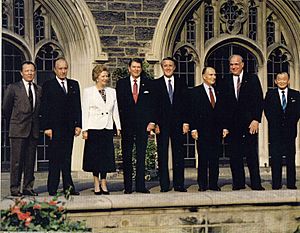Hart House (University of Toronto) facts for kids
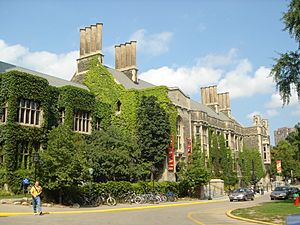 |
|
| Established | 1911 |
|---|---|
| Location | University of Toronto St. George Toronto, Ontario, Canada |
Hart House is a special place for students at the University of Toronto's St. George Campus. It offers many activities and programs for students from all three university campuses. Opened in 1919, it was one of the first student centers in North America. It has been a key spot for student debates and meetings since it was built.
Hart House was started and paid for by Vincent Massey, who was a former student and supporter of the university. He named it after his grandfather, Hart Massey. The building's style is called Collegiate Gothic-revival, and it was designed by architect Henry Sproatt. He worked with decorator Alexander Scott Carter and engineer Ernest Rolph. Sproatt also designed the tall campanile (bell tower) nearby, called Soldiers' Tower. In 1957, a future U.S. President, John F. Kennedy, visited Hart House.
Contents
History of Hart House
When Vincent Massey was a university student, he studied history and English. He later went to Oxford University in England. He was very impressed by the social and fun activities at Oxford's colleges. When he came back to Canada, he wanted to create a similar friendly and united feeling at the University of Toronto.
In 1908, Massey became a trustee of his family's estate. He offered to build a place for student activities at the university. The university leaders loved this idea. The land where Hart House stands was once near a pond and a creek, which were covered up in 1886.
Construction began in 1911. The Massey family had planned to spend $300,000 on the project. However, as they built, Massey and his architect kept adding new ideas. This made the building much bigger and more detailed than first planned. By the time it was finished in 1919, the cost had grown to $2 million.
Hart House was built in the Gothic Revival style. This style was first used for large cathedrals in England and France. These churches were often covered with detailed decorations. These decorations showed Bible stories so that even people who couldn't read could understand religious ideas. Long ago, churches often started universities. Hart House was designed to remind people of this history. The building has long hallways with rooms that have high ceilings and carved details.
Vincent Massey's gift stated that only men could use the building. He believed that having both men and women would spoil the friendly feeling he wanted to create. In the 1950s, this rule caused a lot of discussion as women wanted to be allowed in. Massey stuck to his original rules until he passed away. However, some changes did happen. In 1954, the Arbor Room coffee shop was built, and it was the first place in Hart House where both men and women could be together. Also, in 1958, women were allowed to attend a debate for the first time. But they had to sit behind a rope and were not allowed to speak.
After Vincent Massey died in 1967, the leaders of Hart House changed his gift agreement. This allowed women to become members. Since 1972, women have been able to fully take part in all of Hart House's activities.
During a debate at Hart House on November 14, 1957, John F. Kennedy said he approved of keeping women out of such places. He also said it was nice to be in a country where women couldn't mix in everywhere. This was said even though female students were protesting outside with signs that read "Unfair!" and "We want Kennedy!"

First Commonwealth Conference
The first unofficial meeting of the Commonwealth countries happened at Hart House. It took place from September 11 to 21, 1933. This meeting was called the Commonwealth Relations Conference. It was organized by the Canadian Institute of International Affairs and the UK Royal Institute of International Affairs (Chatham House). Vincent Massey, one of the delegates, invited them.
Former Canadian Prime Minister Sir Robert Borden led the meeting. Arnold Toynbee wrote down what happened. All the Commonwealth nations at that time were there, with 77 international delegates. There were seven Commonwealth countries back then: Canada, Britain, Australia, New Zealand, Newfoundland (which later became part of Canada), South Africa, and the Irish Free State. There is a photo of the delegates in the Debating Chamber of the building. These conferences then happened regularly in different Commonwealth countries until the official Commonwealth Heads of Government Meetings began.
Architecture of Hart House
Hart House is a very large building compared to others nearby. It is taller than it is wide, which makes it look even grander when you stand at its base. From the outside, you can see many large windows on the north and south sides. There are also strong parts that stick out, marking where one section of the building ends and another begins. The building's edges are uneven, which is typical of the Gothic style. This gives Hart House the look of an old academic building.
Inside, you can find many interesting details. In the theater, behind the stage and below ground, there are marks on the back wall. These marks were made by service ammunition, giving the building a unique history. There are also carvings on the walls. The first people who lived in the house are remembered on the south side. Carvings above the map room windows show the main army units that were stationed there during the war. In the Great Hall, there's another special carving. One of the stone supports has been carved to look like an officer cadet from 1916, wearing his uniform and carrying his gear.
Hart House is a great example of Gothic Revival architecture. It is not perfectly balanced, has pointed arches and windows, and lots of decorations. It also has steep roofs and a tall tower. It is considered a "late collegiate Gothic" building because it was built in 1919. The building has four sections built around a central courtyard. A four-peaked tower extends from the southwest corner. Even though Hart House looks like it's made of solid stone, it actually has a steel frame and precast concrete. The outside is covered with grey sandstone. The roofs are made of curved wooden beams. Wood and stone are the main materials used in this building.
Building Design and Details
Most parts of Hart House show the "Perpendicular" style of Gothic architecture. This means elements often line up in rows. Arches and vaults are the main shapes used for support. However, some parts of the building use lintels to create open spaces with flat ceilings, like the East Common Room. The ceilings in the hallways and many rooms, such as the Upper Gallery of the Great Hall, are vaults with raised ribs. The library ceiling is especially notable, with decorative "Lierne" ribs. You can also see these in the entrance vaults.
The shapes of the main entrances and the Tudor-like archways match the shapes of the chimney arches. The decorative clover-like shapes used for the windows also appear in the wooden parts of doors and roof supports. The main entrance on the south side, the entrance on the west side, and the entire east wall have a "Perpendicular" style top with battlements (like a castle wall). The Gothic look of the building is clear in its structure, layout, and decorations. The heavy look of the stone is made lighter by its carvings and by the thin, colorful stained-glass windows.
Similar to the Romanesque style, Gothic or Gothic-revival buildings use stone for construction. The rough, dark sandstone and limestone on the outside contrast with the smooth brick inside. Pointed arches are common for windows, doors, and hallways. The porch is another Gothic-revival feature added by architect Henry Sproatt. It's a covered area in front of the main entrances, offering shelter from bad weather. The decorated wooden arch-braces and ceilings help to make the sound better for the Hart House Orchestra.
Even though Gothic style details are simpler than Romanesque, Hart House still has decorative stone and wood carvings inside and out. On the south side, near the top, there's a line of small stone sculptures of human heads. There are also stone lions and monkeys on either side of the main doors. The wooden arch braces on the flat roofs of the east hallways have carved decorations. The windows have clover-like designs near the top. Even the university's crest and motto are carved into the front of Hart House. These carvings add beautiful details to the building.
How Hart House is Managed
Hart House is managed in a way that encourages teamwork and democratic decisions. It is overseen by the Board of Stewards. This group includes student leaders from different committees, a representative from the Finance Committee, and student governments from the University of Toronto campuses. It also includes the head of the Alumni Committee, a senior member from Recreational Athletics, the University President (or someone they choose), two people chosen by the President, and one person chosen by the Governing Council. The warden is the main leader of Hart House.
In October 2022, Sherry Kulman became the Interim Warden. The Board of Stewards decides how the space in Hart House is used. They also approve the building's budget and work with the warden to plan for the future of Hart House. Most of the members on the Board of Stewards are students.
Leaders of Hart House (Wardens)
- Walter F. Bowles (1919–1921)
- J. Burgon Bickersteth (1921–1947)
- Nicholas Ignatieff (1947–1952)
- Joseph McCulley (1952–1965)
- E. Arnold Wilkinson (1965–1972)
- J. G. Langelle (1972–1977)
- Richard M. H. Alway (1977–1990)
- Paul McCann (Acting Warden) (1990-1992)
- Peter Turner (1992-1997)
- Margaret Hancock (1997-2007)
- Louise Cowin (2007 to 2011)
- Bruce Kidd (2011–2015)
- John F. Monahan (2015–2022)
- Sherry Kulman (Interim Warden) (2022–2023)
- David Kim (2023–)
Art Museum at the University of Toronto
The Art Museum at the University of Toronto includes two galleries: the Justina M. Barnicke Gallery (at Hart House) and the University of Toronto Art Centre (at University College). These two galleries are very close to each other. In 2014, they joined together and became the Art Museum at the University of Toronto. This is now one of the largest places for art exhibitions and programs in Toronto.
The Art Museum has a collection of Canadian art, both old and new, from 1921 to today. Its exhibits often show modern Canadian art in all forms. The gallery also hosts movie showings, talks, and performance art.
Besides its regular exhibits, the gallery has an art collection worth over $10 million Canadian dollars.
Clubs and Activities at Hart House
Hart House Chess Club
The Hart House Chess Club started in 1895, making it one of the oldest and most successful clubs at the University of Toronto. It meets every Friday from 4 pm to 11 pm in the Reading Room at Hart House. Players of all skill levels are welcome to play for fun or seriously. The club offers lessons from some of Canada's best players and hosts rated tournaments. The Hart House Chess Team has won the top prize six times at the Pan American Intercollegiate Team Chess Championship.
Many famous chess players have visited the club over the years. These include Paul Keres, Samuel Reshevsky, George Koltanowski, and World Chess Championship winners like Bobby Fischer, Max Euwe, Mikhail Botvinnik, Boris Spassky, and Evgeny Bareev.
Hart House Debating Club
In 1986, the University of Toronto Debating Union joined with the Hart House Debates Committee. This agreement gave the Union support from Hart House. The group was renamed the Hart House Debating Club. Since then, it has been the main speech and debating club at the University of Toronto. It is open to all students from all colleges and campuses.
The Hart House Debating Club has welcomed many important speakers. These include world leaders, government officials, filmmakers, business leaders, activists, poets, and people who help others. Some famous speakers include John F. Kennedy, Christopher Hitchens, Margaret Atwood, and Donald Sutherland.
The club has hosted many important tournaments. These include the North American Debating Championship and the World Universities Debating Championship. The club has won the World Universities Debating Championship twice, in 1981 and 2006.
Hart House Literary and Library Committee
This committee organizes many literary events at Hart House throughout the school year. These include writing groups like le mot juste and the Algonquin Square Table. They also publish the Hart House Review. The committee often has a writer-in-residence who leads workshops and gives feedback on student writing. The committee also runs a library on the second floor of Hart House. It has many books for research and fun reading. The library is often used for public readings, which the committee also arranges.
Hart House Music Committee
This committee organizes concerts and events for different types of music, such as rock, reggae, and folk. The concerts are free for everyone in the university community. The committee puts on six to ten concerts during the school year. These events are becoming a bigger part of Hart House. The committee wants to bring together all music lovers from every campus. Hart House also hosts open mic nights, which are open to everyone. These events are considered a "must see" for all new students.
Hart House Review
The Hart House Review (HHR) is a Canadian literary journal. It is published by student members of Hart House at the University of Toronto. The magazine is known for its stories, poems, and photos contributed by new writers and artists in Canada. Famous Canadian writers like Rohinton Mistry and Camilla Gibb have had their work published in the HHR. The review also hosts talks and readings with well-known and new figures in Canadian literature and publishing.
Lecture Series
The Hart House Hancock Lecture is a yearly public talk. A committee of students, staff, and alumni chooses the speaker. It usually takes place in late March in the Great Hall of Hart House. This lecture series started in 2001. The goal was to have an important public lecture at Hart House every year.
In 2007, Professor Darin Barney from McGill University gave a talk. It was called "One Nation Under Google: Citizenship in the Technological Republic." He talked about how technology and being a citizen are connected.
In 2008, Samantha Nutt, founder of Warchild Canada and a U of T Professor, gave a lecture. Her talk was "The World is Our Backyard: Individual Responsibility for a Global Society." Dr. Nutt spoke about the role of people in North America and their ability to help in countries affected by war.
Other past speakers include Michael Geist (2006), David Bornstein (2005), Jennifer Welsh (2004), Alan Lightman (2002), and Pico Iyer (2001). You can find copies of some past lectures online.
Theatre at Hart House
Hart House Theatre is often called the starting point of Canadian Theatre. It opened in November 1919. This Art Deco style theatre on the University of Toronto's St. George campus quickly became a leader in the "Little Theatre" movement of the 1920s and 1930s. Hart House Theatre helped and showed some of Canada's best actors, directors, writers, and designers before World War II. These included Raymond Massey, Dora Mavor Moore, and Lawren Harris.
After the war, Hart House Theatre became a student theatre for extra-curricular activities, led by Robert Gill. For twenty years, it helped a new group of stage professionals get their start. Many famous people began their careers on the Hart House stage, such as William Hutt, Don Harron, Donald Sutherland, Norman Jewison, and Lorne Michaels.
By the mid-1960s, the theatre became part of university studies with the creation of the Graduate Centre for Study of Drama. A new group of students combined studying plays with hands-on theatre experience. They learned from and added to the lively Toronto theatre scene of the 1970s.
Today, Hart House Theatre is the main place for performing arts at the University of Toronto. Each year, over a thousand students take part in its extra-curricular drama, dance, music, and film programs. Hart House Theatre continues to influence new generations. The performances often receive good reviews from art critics and almost always sell out.
Hart House Orchestra
Since 1976, the Hart House Orchestra (HHO) has given members of the University of Toronto community a chance to play challenging orchestral music together.
The orchestra has 80 to 90 musicians. Members are chosen each year through auditions. Students at all levels, alumni, faculty, staff, and senior Hart House members can audition. In a typical year, the orchestra performs three concerts at Hart House and one in another city in Ontario or Quebec. They have toured to places like Montreal, Ottawa, and Kingston. On a few special occasions, the orchestra has even toured to Carnegie Hall in New York City and cities in Germany and the U.S. A committee of volunteer orchestra members manages the orchestra's operations.
Each year, the orchestra holds two concerto competitions. One is for its own members, and the other is open to the wider community. The winning soloists get to perform with the orchestra, usually in the next season.
Hart House Film Board
This popular club helps its members make movies. It offers equipment to rent and provides instruction. It also organizes group projects, like the New Filmmaker's Project, and film screenings. Famous filmmakers like Atom Egoyan and Babak Payami made their first films using Hart House Film Board equipment. Since 2006, The Hart House Film Board has offered many film training classes.
Other Features of Hart House
Hart House is a beautiful building, which makes it a popular place for weddings, professional meetings, and other events. Hart House also has a barbershop for students. In addition, Hart House owns and manages a 150-acre (0.61 km2) farm in the Caledon Hills. This farm has been a popular retreat for a long time.
Famous Visitors to Hart House
Since 1919, almost all important people who visited Hart House signed its guest book. In 2007, the original leather-bound book finally ran out of pages and had to be replaced.
The first royal visitor to Hart House was Prince Edward, Prince of Wales. He played squash with students there in 1924. In 1939, King George VI and Queen Elizabeth toured the campus and had lunch at Hart House. Elizabeth II made her first visit as a princess in 1951.
Several people have signed the guest book more than once during different visits to Hart House. Famous visitors include:
- Dwight D. Eisenhower
- Ronald Reagan
- John F. Kennedy
- Thomas Mann
- Stephen Leacock
- Henry Moore
- Seamus Heaney
- Octavio Paz
- John Kenneth Galbraith
- Christopher Hitchens
- Edmund Hillary
- King George VI
- Queen Elizabeth II
See also
- Survivors Are Not Heroes, a sculpture outside the building


